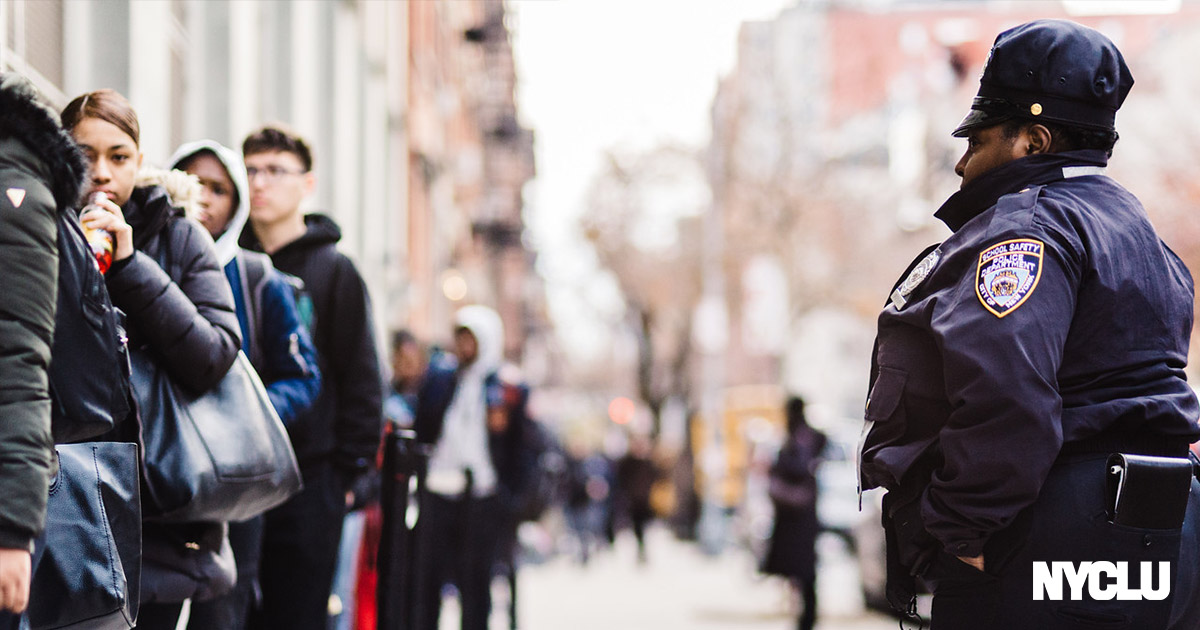Column: Constitutional Limits on Congressional Investigations Into Palestine-Israel Advocacy
Civil Liberties Union

As New York City public school students head back to school this week, the days when NYPD officers could arrest students for minor misbehavior may finally be over.
After more than two decades in which the NYPD had near total discretion, the Department signed a policy in June that limits the responsibilities of police officers in New York City public schools. The policy is part of a school climate effort by Mayor Bill de Blasio that also includes hiring 285 new school social workers, limiting out of school suspensions, and providing support for educators to practice positive discipline techniques. It’s a sweeping, ambitious, and impressive package, driven in large part by advocates and youth organizers.
It is singularly impressive that the NYPD, the nation’s largest police force, once described by Michael Bloomberg as “the 7th biggest army in the world,” agreed to restrain the authority of its officers in the school context.
This is especially remarkable in our current cultural moment—a post-Parkland world where school districts are pressured to purchase weapons, grant law enforcement access to student records, and spend limited education dollars on high-tech surveillance. The NYPD, the majority of whose School Safety Division officers are and will remain unarmed, is taking a drastically different approach.
The agreement, known as a Memorandum of Understanding (MOU), puts student wellbeing at the center of school security. It replaces a Giuliani-era MOU that allowed police to arrest students of any age for any classroom infraction. That MOU was executed at the height of “Broken Windows” policing in New York, a strategy that targeted mostly Black New Yorkers for minor violations of the law, under the flawed theory that it could deter more serious crime. It imported a culture of zero tolerance into classrooms, with complete disregard for normal childhood and adolescent behavior, or the importance of young people learning from their mistakes.
The number of School Safety Officers ballooned, leading to more arrests and conflicts, not fewer. The DOE ratcheted up its Citywide Discipline Code, dramatically increasing the number of infractions that could result in an out-of-school suspension, eventually peaking at more than 70,000 suspensions in a single school year. In 2007, then-NYPD Commissioner Raymond Kelly wrote to the City Council that the role of School Safety Officers included “removing unruly students” and enforcing school rules.
The NYCLU fielded complaints from families whose children were arrested for ridiculous “offenses” like being suspected of having a cell phone, starting a food fight, bringing banned sugary drinks into school, or refusing to remove a baseball cap in class. NYPD officers even arrested principals and teachers for trying to protect their students.
We will continue to work towards a system where every child has access to a school that is safe, healthy, and free.
The new MOU seeks to close the book on this culture, and while it preserves the NYPD’s control over school safety, it rightly directs their attention to addressing serious safety threats. It does not prohibit officers from arresting students or educators from calling the police, but it communicates that children should not be subjected to police tactics for common behavioral problems.
It is a meaningful values statement from the largest school district in the country.
Getting the city to this point was not easy. At the center of the fight, for more than a decade, was a dedicated group of advocates, and several generations of powerful youth activists.
We began to turn the tide by telling these stories over and over again, through personal anecdote, policy critique, and data. With the help of City Council members, we passed strong local reporting requirements to get access to school arrest numbers and demographic information.
As in other cities, we learned that arrests of students in our schools showed striking racial disparities. Black and Latinx students represented almost 90 percent of arrests in a given reporting period. Young people marched on City Hall, testified at Council hearings, filed official complaints against abusive officers, and sued the City for wrongful arrests and unreasonable use of force.
When a new mayor was elected in 2013, we were poised to make change happen. As part of Mayor de Blasio’s School Climate Leadership Team, advocates, parents, and young people worked shoulder-to-shoulder with the police department to reach an understanding that arresting misbehaving students did not make schools safer. In fact, it was a practice that made schools hostile and dangerous for any student having a bad day, especially if they had special needs or were a child of color.
The police are trained to always plan for the worst, but we managed to show them that the worst wasn’t happening. Schools, like the streets of New York City, were getting safer, even as arrests began to drop. Terrifying scenarios like a school shooting would not be thwarted by handcuffing food fighters.
In the absence of new policy from the City, the Division reduced arrests by voluntarily participating in conflict resolution and other trainings, at the behest of youth leadership. They adopted a diversion strategy for handling non-criminal violations. And they worked with us to keep solving problems.
The MOU doesn’t address everything. We must work to limit the use of handcuffs, metal detectors and other forms of surveillance, and seek drastic improvements to the way the NYPD responds to children in emotional crisis. The School Safety Division is actually growing this year, which provides more opportunities for conflict with students, even under the new agreement. But we’ve started the work of policy change, and the culture change is well underway.
We will continue to work towards a system where every child has access to a school that is safe, healthy, and free.
This piece originally appeared on the Heckinger Report.